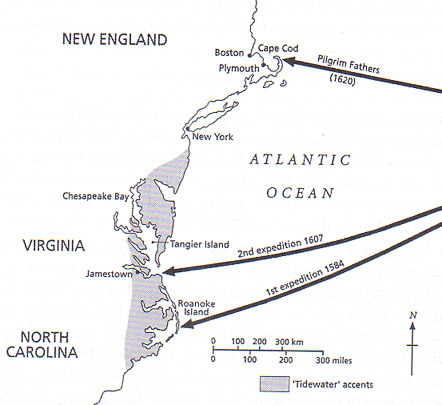Geographic Distribution
of Living Languages, 2006 (http://www.ethnologue.com/ethno_docs/distribution.asp
)
|
||||||||||||||||||||||||||||||||||||||||||||||||||||||||||||||||||||||||||||||||||||||||||||||||||||||||||||||||||||||||||||||||||||||||||||||||||||||||||||||||||||||||||||||||||||||||||||
|
The 30 Most Spoken Languages of the World
|
||||||||||||||||||||||||||||||||||||||||||||||||||||||||||||||||||||||||||||||||||||||||||||||||||||||||||||||||||||||||||||||||||||||||||||||||||||||||||||||||||||||||||||||||||||||||||||
http://www.krysstal.com/spoken.html
Map of the English Language
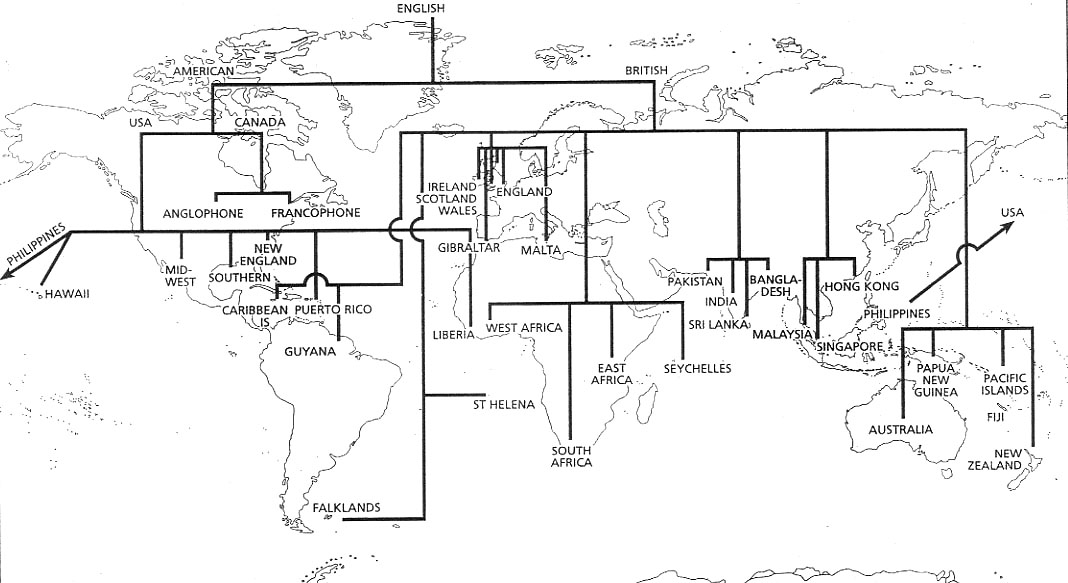
The English language took root as English settlements were established:
- in the Middle Ages in southern Ireland and south-west Scotland;
- in the 17th and 18th centuries in North America, the Caribbean, and northern Ireland;
- and in the 18th and 19th centuries in Australasia and Africa.
English as a Global Language
UK: 58.100.000
USA: 237.300.000
Lingua franca: 267.000.000
Canada: 18.200.000 [French 7.158.000]
India: 210.000
Lingua franca: 193.000.000
Australia: 15.500.000
Lingua franca 18.500.000
New Zealand: 3.388.000
South Africa: 3.700.000 [Afrikaans: 6.220.000](EB data 2001)
English is spoken as a native language by nearly four hundred million people and has become a lingua franca, the Latin of the modern world, "spoken in every continent by approximately eight hundred million people" (Todd iv).
More radical estimates, which include speakers with a lower level of language fluency and awareness, have suggested that the overall total is these days well in excess of 1,200/1,500 million. (Crystal 360)
In addition, it is estimated that 75 percent of all international communication in writing, 80 percent of all information in the world's computers, and 90 percent of Internet content are in English.
NEW ENGLISHES
• English as first language
• English as second language where the language is the official language or a second-language in a multilingual setting
• English as foreign language. Nations which recognize the importance of English as an international language though they do not have a history of colonization [When a language is used as a means of communication between persons having no other language in common, it is a lingua franca.]
• English based Pidgin [A lingua franca native to none of those using it and with a sharply reduced grammar and vocabulary is called a pidgin. (This definition of pidgin excludes both the broken English of a beginning learner and the skillful but no-native use of English in such countries as India.) ]
• English based Creole [When a whole speech community gives up its former language or languages and takes a pidgin as its mother tongue, the pidgin becomes a creole (is creolized).]
A complex interrelationship
The linguist Braj Kachru uses concentric circles to illustrate his concept of how the Englishes differ from one another, and of the relationships between them, as follows:• The inner circle (English as first language): Australia, Canada, Ireland, New Zealand, UK, USA
• The outer circle (English as second language where the language is the official language or a second-langauge in a multilingual setting): Bangladesh, Ghana, Hong Kong, India, Kenya, Malaysia, Nigeria, Pakistan, Philippines, Singapore, Sri Lanka, Tanzania, Zambia
• The expanding circle (English as foreign language; Nations which recognize the importance of English as an international language though they do not have a history of colonization): China, Egypt, Indonesia, Israel, Japan, Korea, Nepal, Saudi Arabia, Taiwan, USSR
Factors which shaped the varieties of English
From the time at which each new area was colonized, and the settlers were separated from their mother country (from the early 17th century until the late 19th century), the English spoken there began to evolve its own characteristic form.
Isolation
- The dialect of the area of Britain from which the settlers originated had an impact upon the vocabulary of the new settlement.
The regional British accents of the original settlers affected the pronunciation of the English developing in the new settlements.- The indigenous languages encountered in each new colony by English-speaking colonists invariably had an impact upon the English developing there.
- The relative size of the English settlement was significant in determining the type of English that developed there.
- The new English-speaking communities have filled gaps in vocabulary, not only by borrowing and by loan translation from the languages they encountered, but also by the creation of new English words and phrases (as is the case in any language community).
from: David Crystal, Cambridge Encyclopedia of the English Language
England
The abbreviation RP (Received Pronunciation) denotes the speech of educated people living in London and the southeast of England and of other people elsewhere who speak in this way.
If the qualifier educated be assumed, RP is then a regional (geographical) dialect, as contrasted with London Cockney, which is a class (social) dialect. RP is not intrinsically superior to other varieties of English; it is itself only one particular regional dialect that has, through the accidents of history, achieved more extensive use than others.
RP is a phonological variant (http://www.ic.arizona.edu/~lsp/)
- English English (standard English)
- Northern Dialect
- Midland Dialect
- South Western
- Wales
- Standard Scottish English and Scots [http://www.linguist.de/reese/English/scotland.htm; http://www.eng.umu.se/city/Fredrik/city/scottish.htm]
- Irish
Languages of United Kingdom http://www.ethnologue.com/show_country.asp?name=GB
Traditional counties of England
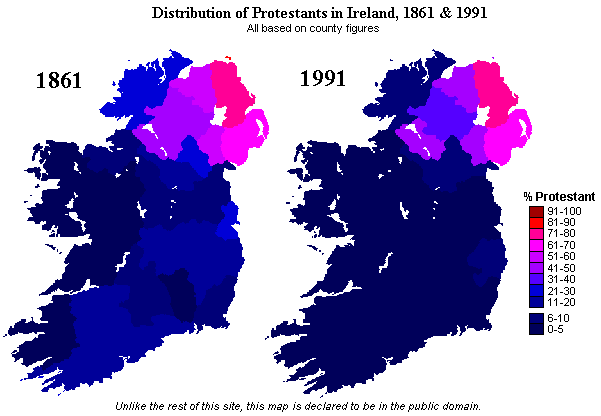
America
United States of America. 293,027,571. National or official languages: American English, Hawaiian (in Hawaii), Spanish (in New Mexico). Literacy rate: 95% to 99%.
Migrations
Native Americans
1520 - Spanish were the first
1600-1900 – 11-12 Million black slaves
1620 – Pilgrims arrived in Plymouth
1682 – French arrive in Louisiana
1720s/1730 – Amish arrival
1763 – first Asian arrival (Filippines)
1830 – Immigrant from Nordic countries
1840s - Irish Potato Famine; crop failures in Germany; the onset of industrialization; and failed European revolutions begin a period of mass immigration
1880-1913 – East Europeans arrivalEuropean migrations
Irish Catholics:
1815-1845 pre-famine emigration
1845-1853 massive exodus Italian
Portugueses:
1900 from Azores
East Europe:
1880-1913 Jews from Russia
1919-1924 Poles, Lithuanians, Czechs, Slovaks, Hungarians
German:
1815-1914 transatlantic exodus
Three-quarters of all immigrants live in six states: California, Florida, Illinois, New Jersey, New York, and Texas; and more than half of these migrants settled in just eight metropolitan areas.
English Language Unity Act of 2003 (Introduced in House) http://www.us-english.org/inc/legislation/federal/hr997.asp
Canada
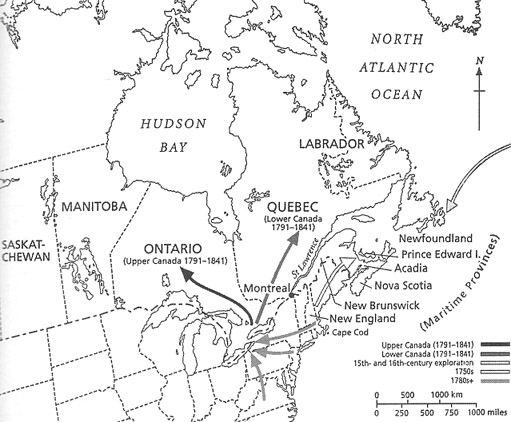
Canada remains bilingual. One-fourth of its people, living mostly in the province of Quebec, have French as their mother tongue. Those provinces in which French is spoken as a mother tongue by 10 percent or more of the population are described as "federal bilingual districts" in the Official Languages Bill of 1968.
ENGLISH [ENG] 17,100,000 mother tongue speakers in Canada, or 60% of the population (1998 Statistics Canada). 820,000 mother tongue speakers in Quebec (1995 Statistics Canada); plus another 1,500,000 in Quebec whose first or second language is English (1995 Statistics Canada). Dialects: NEWFOUNDLAND ENGLISH. Classification: Indo-European, Germanic, West, English.
More information.
FRENCH [FRN] 6,700,000 mother tongue speakers in Canada, or less than 24% (1998 Statistics Canada). Mother tongue of over 80% of Quebec's population (1997 DiverCite Langues). 300,000 speak Acadien, 500,000 speak Franco-Ontariens. Québécois is in Québéc, Franco-Ontariens in Ontario, Acadian is in Caraquet, Shippagan, the east coast of New Brunswick, pockets in Nova Scotia and Prince Edward Island. Some Québécois speakers in Manitoba. Alternate names: FRANÇAIS. Dialects: QUÉBÉICOIS, FRANCO-ONTARIEN, ACADIAN (ACADIEN). Classification: Indo-European, Italic, Romance, Italo-Western, Western, Gallo-Iberian, Gallo-Romance, Gallo-Rhaetian, Oïl, French.
The Caribbean
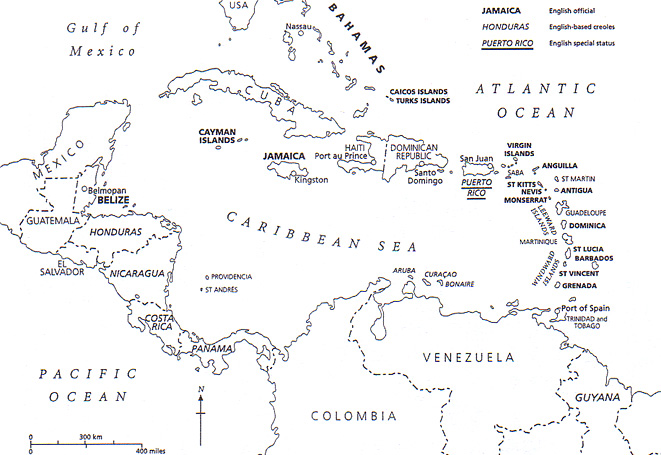
The policy of slave-traders was to bring people from different language backgrounds together in the ships, to make it difficult for groups to plot rebellion. The result was the growth of several pidgin forms of communication, and in particular a pidgin between the slaves and the sailors, many of whom spoke English > black creole = West Indian Speech (also in Canada, Costa Rica, Dominican Republic, Panama, United Kingdom, USA. ).
Standard British English was becoming a prestige variety throughout the area, because of the emerging political influence of Britain.
Australia and New Zeland
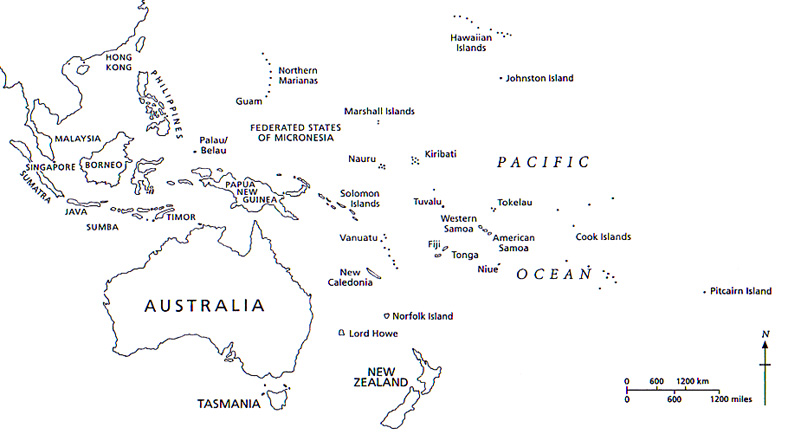
Unlike Canada, Australia has few speakers of European languages other than English within its borders. There are still many Aboriginal languages, though they are spoken by only a few hundred speakers each and their continued existence is threatened. More than 80 percent of the population is British. By the mid-20th century, with rapid decline of its Aboriginal tongues, English was without rivals in Australia.
The number of languages listed for Australia is 268. Of those, 235 are living languages, 2 are second languages without mother tongue speakers, and 31 are extinct.
prisoners form London and Ireland > Cockney and Irish dialects
New Zeland: 1) incomparison with Australia, there has been a stronger sense of the historical relationship with Britain, and a greater sympathy for British values and institutions. Many people speak with an accent which displays clear British influence. 2) there as been a growing sense of nation identity, and a particular emphasis on the differences between New Zeland and Australia. > Differences of accents of the two countries, and a distinctive New Zeland vocabulary; 3)there has been a fresh concern to take account of the rights and needs of the Maori people, who now form over 10% of the population > increased use of Maori words in New Zeland English.
South Africa
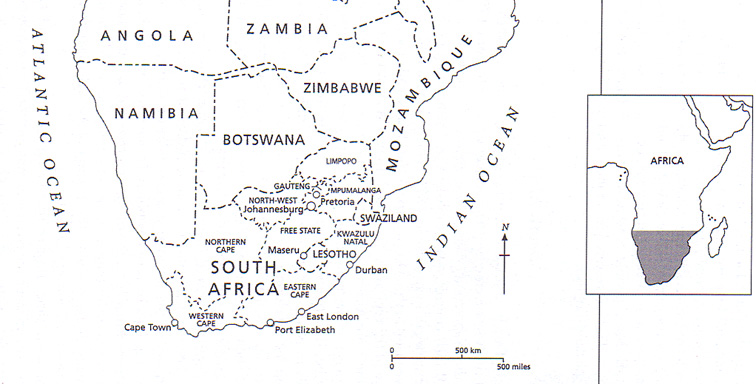
1. the Speech of the London area is prominent in the Cape
2. Midands and northern Bristish speech is represented in Natal > a more homogeneous accent emerged - an accent that shares many similarities with the accents of Australia, which was also being settled during this period.
3. English was being used as a second language by many Afrikaans speakers (North)
4. an African variety of English developed spoken by black people, who had learned the language in mission schools, and which was influenced in different ways by the various language backgrounds of the speakers.
5. English was adopted by immigrants from India who arrived from around 1860.
South Asia
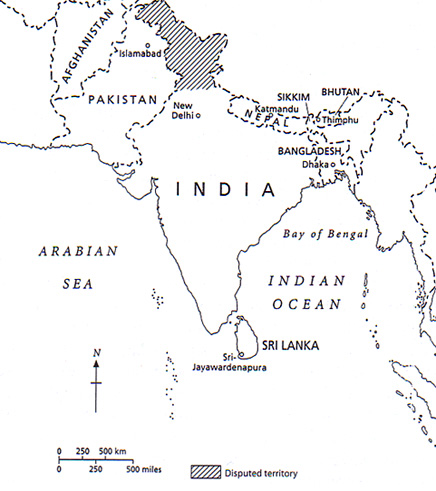
In terms of numbers of English speakers, the indian subcontinent ranks third in the world after USA and UK [India, Bangladesh, Pakistan, Sri Lanka, Nepal Bhutan (they hold a fifth of the world's population)]. > South Asian English
In India: Official languages: Assamese, Bengali, Gujarati, Hindi, Kannada, Kashmiri, Malayalam, Marathi, Oriya, Panjabi, Sanskrit, Sindhi, Tamil, Telugu, Urdu, English (Associate Official).
The number of languages listed for India is 398. Of those, 387 are living languages and 11 are extinct.
In Pakistan, it is an associated official language.
Other States: it is used as a medium of international communication.
Former colonial Africa
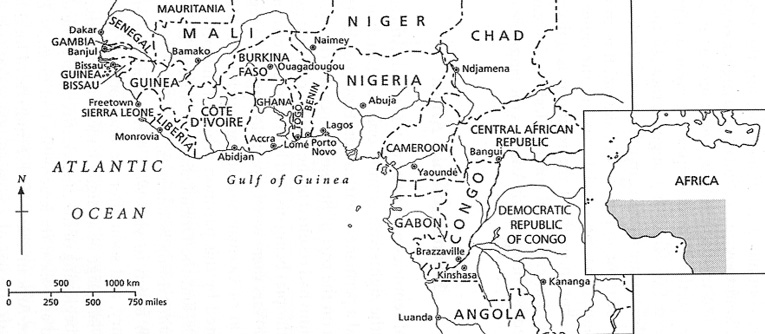

South Asia and the South Pacific

http://www.us-english.org/inc/legislation/federal/hr997.asp USA
http://www.une.edu.au/langnet/aave.htm#vocab-hce Ebonics
Summary
P. Tornaghi - ML Maggioni, Arcipelago inglese, Sugarco Ed., Milano 2002
D. Crystal, Varieties of English, Cambridhe UP
AskOxford
The concept ‘World Englishes’ encompasses a wide range of variables.
First, the ‘political’:
• English fulfils a variety of roles worldwide: it can be national language, official language, administrative language, language of communication, second language, or third (or even fourth) language.
• The forms taken by English worldwide range between standard English at the one end of the spectrum and pidgin English at the other. Many varieties fall somewhere between the two extremes.
• The position held by English may be unassailable, as in the United Kingdom, New Zealand, or Australia, or it may be challenged by other languages, as in Quebec (Canada), South Africa, and (increasingly) the United States.
• While English may be important as the language of commerce, education, and government, it is not always the first language of the majority of citizens of a country. This sometimes leads to a reaction against English as an elitist ‘colonial’ language—or to demands that the local variety of English be recognized as ‘standard’. Reactions to English can be ambivalent: it can be aspired to and yet resented.Secondly, the linguistic:
• Some English words originated in a regional variety, but are now assimilated into the wider vocabulary of English, with their regional origins no longer recognized—as budgerigar (Australia), bungalow (South Asia), and trek (South Africa). Other words (for example bluey, chotapeg, donga, from the same three regions), while important in their own variety, are rarely used or understood elsewhere.
• Some English words, now archaic or dialectal in Britain, survive in general use only in one of the former British possessions.
• Some regional words are general English words to which new meanings have been assigned.
• Some regional words are borrowed from other languages with which English has come into contact; some are loan translations from these languages; and some are entirely new words or phrases, created in the region.
• One word can mean many things throughout the English-speaking world; conversely, one object can be given many different names worldwide (for example the shoes known as gymshoes, plimsolls, sneakers, and tackies).
• Some words describe cultural or topographical phenomena found only in one region (boomerang, haka, teepee); other words describe something known everywhere but not given a name elsewhere (Scotch call, the name in South Africa for a message given to someone by allowing the telephone to ring twice before ringing off).





